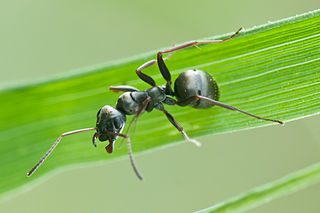
The white-throated kingfisher also known as the white-breasted kingfisher is a tree kingfisher, widely distributed in Asia from the Sinai east through the Indian subcontinent to the Philippines. This kingfisher is a resident over much of its range, although some populations may make short distance movements. It can often be found well away from water where it feeds on a wide range of prey that includes small reptiles, amphibians, crabs, small rodents and even birds. During the breeding season they call loudly in the mornings from prominent perches including the tops of buildings in urban areas or on wires.

Giant cockroaches, or blaberids are the second-largest cockroach family.

Nepenthes fusca, or the dusky pitcher-plant, is a tropical pitcher plant endemic to Borneo. It is found throughout a wide altitudinal range and is almost always epiphytic in nature, primarily growing in mossy forest.

Nepenthes vogelii is a tropical pitcher plant endemic to Borneo. It is thought to be most closely related to N. fusca.

Nepenthes platychila is a tropical pitcher plant endemic to the Hose Mountains of central Sarawak. It is notable for its smooth peristome and funnel-shaped upper pitchers. Nepenthes platychila belongs to the loosely defined "N. maxima complex", which also includes, among other species, N. boschiana, N. chaniana, N. epiphytica, N. eymae, N. faizaliana, N. fusca, N. klossii, N. maxima, N. stenophylla, and N. vogelii.

Formica fusca, a black-colored ant commonly found throughout Europe as well as parts of Southern Asia and Africa. The range within the palaearctic region extends from Portugal in the west to Japan in the east and from Italy in the south to Fennoscandia in the north. Populations from North America have been split off as a separate species, Formica subaenescens. F. fusca nests are usually found in rotten tree stumps or under stones in clearcut areas and along woodland borders and hedgerows.

Aplonis is a genus of starlings. These are essentially island species of Indonesia, Oceania and Australasia, although some species' ranges extend to the Malay Peninsula, southern Vietnam and northeastern Queensland. The typical adult Aplonis starling is fairly uniformly plumaged in black, brown or dark green, sometimes with a metallic gloss. The eye ring is often distinctively coloured. Immatures of several species have dark streaked pale underparts.

Nothofagus fusca, commonly known as red beech is a species of southern beech, endemic to New Zealand, where it occurs on both the North Island and South Island. Generally it is found on lower hills and inland valley floors where soil is fertile and well drained. In New Zealand the species is called Fuscospora fusca.

The Tasman starling was described in 1836 by John Gould as a species which occurred on both Norfolk Island and Lord Howe Island. In 1928 Australian ornithologist Gregory Mathews recognized that the plumage of the race from Lord Howe Island was much browner and more greyish than the plumage of the Norfolk Island race and split the species into two forms, the Norfolk starling, and the Lord Howe starling. Both subspecies are now extinct, thus so the species.

Erythrina fusca is a species of flowering tree in the legume family, Fabaceae. It is known by many common names, including purple coraltree, gallito, bois immortelle, bucayo, and the more ambiguous "bucare" and "coral bean". E. fusca has the widest distribution of any Erythrina species; it is the only one found in both the New and Old World. It grows on coasts and along rivers in tropical Asia, Oceania, the Mascarene Islands, Madagascar, Africa, and the Neotropics.
The dusky tube-nosed bat is a species of vesper bat in the family Vespertilionidae. It is found only in China.

Chaperina fusca is a species of frog in the family Microhylidae. It is monotypic within the genus Chaperina. It is found on the Malay Peninsula, in Borneo and in the Philippines. It is abundant in Borneo but uncommon on the Malay Peninsula and patchily distributed in the Philippines.

Malus fusca, with the common names Oregon crabapple and Pacific crabapple, is a North American species of crabapple.

Ophrys fusca, commonly known as the sombre bee-orchid or the dark bee-orchid, is a species of orchid native to the Mediterranean from southwestern Europe and northern Africa to western Asia.

Leptochloa is a widespread genus of Asian, African, Australian, and American plants in the grass family.
Nepenthes epiphytica is a tropical pitcher plant known only from the Berau and East Kutai Regencies of East Kalimantan, Borneo, where it grows at an elevation of around 1000 m above sea level. Prior to its formal description as a species, N. epiphytica was considered to be a variant of the closely related N. fusca. Nepenthes epiphytica belongs to the loosely defined "N. maxima complex", which also includes, among other species, N. boschiana, N. chaniana, N. eymae, N. faizaliana, N. fusca, N. klossii, N. maxima, N. platychila, N. stenophylla, and N. vogelii.

Sybra is a genus of beetles in the family Cerambycidae, containing the following species:

Sybra umbratica is a species of beetle in the family Cerambycidae. It was described by Pascoe in 1865.

Sybra ordinata is a species of beetle in the family Cerambycidae. It was described by Bates in 1873.
Sybra pascoei is a species of beetle in the family Cerambycidae. It was described by Lameere in 1893.



















